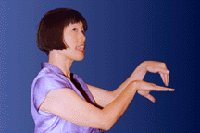 |
| Photo credit: Sunburst media.com |
Chan's repertoire of hand gestures used for both initial teaching and providing feedback is, in many ways, emblematic of behaviourist approaches to language teaching: the instructor signals to the learner, points out what to correct. The idea is that the learner then takes note or "uptakes" the correction and goes ahead to integrate that new form into spontaneous speaking or at least spontaneous listening.
Had a German English teaching colleague a couple of decades ago who fervently believed that to "weist darauf hin" (point out) was his only pedagogical responsibility when it came to assisting students with pronunciation change. It was their problem from there on . . . He, too, had a neat gesture system. It was, indeed, only a "gesture," however.
We "hapticians" (haptic pronunciation teaching enthusiasts) who work with EHIEP (Essential haptic-integrated English Pronunciation) or the haptic video system, AHEPS (Acton Haptic English Pronunciation System) have been focusing for some time now on spontaneous correction of pronunciation in class. The basic concept is that (a) students have been earlier introduced to not just a sign that lets them know what they may need to work on, but rather (b) how to figure out the source of the problem, themselves, and (c) what to do once they do.
For example, say a student uses the wrong vowel in a word. The interaction may go something like this:
A. Instructor: What is the number of the vowel in that word? (Morley, 1992)
B. Learner: (Considers for a second and then takes her best guess: "Ah . . . vowel #4)
C. Instructor either confirms or provides the correct vowel number.
Students had earlier been introduced to the vowel system and a set of haptic techniques for anchoring the sound (with gesture and touch).
D. Learner and instructor then practice the word briefly 3 or 4 times together with a (haptic) pedagogical movement pattern, i.e., "Do that word with me!" (We do not use the dictum: Repeat after me.)
E. Learner writes down the problematic word/phrase immediately and then later
F. She puts it on her current practice word list that is systematically practiced for about 2 weeks, 3x each week.
If you are new to haptic pronunciation teaching, now might be a good time to "sign on!" A good place to start would be at the Haptic Pronunciation Teaching Workshop on Saturday, March 28th, 9:30 a.m., at the TESOL Convention in Toronto!
No comments:
Post a Comment